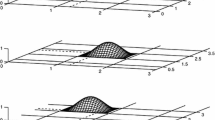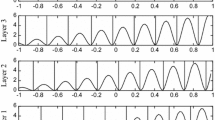Abstract
In this paper we discuss the learning convergence of the cerebellar model articulation controller (CMAC) in cyclic learning. We prove the following results. First, if the training samples are noiseless, the training algorithm converges if and only if the learning rate is chosen from (0,2). Second, when the training samples have noises, the learning algorithm will converge with a probability of one if the learning rate is dynamically decreased. Third, in the case with noises, with a small but fixed learning rate ε the mean square error of the weight sequences generated by the CMAC learning algorithm will be bounded byO(ε). Some simulation experiments are carried out to test these results.
Similar content being viewed by others
References
Albus J S. A new approach, to manipulator control: the cerebellar model articulation controller (CMAC).Trans. ASME, J. Dynamic Syst. Meas. Contr., 1975, 97: 220–227.
Rumelhart D E, Hinton G E, Williams R J. Learning internal representations by error propagation. In: Rumelhart D E, McClelland J L, eds., Parallel Distributed Processing — Explorations in the Microstructure of Cognition. MIT Press, Cambridge, MA, 1986, pp. 318–362.
Miller W T. Sensor based control of robotic manipulators using a general learning algorithm.IEEE J. Robotics Automt., 1987, RA-3: 157–165.
Miller W T. Real-time application of neural networks for sensor-based control of robots with vision.IEEE Trans. Syst., Man, Cybern., 1989, 19: 825–831.
Miller W T, Glanz F H, Kraft L G. An associative neural network alternative to backpropagation. Proc. IEEE, 1990, 78: 1561–1567.
Geng Z, Haynes L. Neural network solution for the forward kinematics problem of a stewart platform. In: Proc. IEEE Int'l Conf. Robotics and Automation, Sacramento, CA, 1991, pp. 2650–2655.
Lin C S, Kim H. CMAC-based adaptive critic self-learning control.IEEE Trans. Neural Networks, 1991, 2(5): 530–533.
Wong Y F, Sideries A. Learning convergence in the cerebellar model articulation controller.IEEE Trans. Neural Networks, 1992, 3(1): 115–121.
Young D M. Iterative solution of large linear systems. Academic Press, New York, 1971.
Kohonen T. An adaptive associative memory principle.IEEE Trans. Comput., 1974, pp. 444–445.
Luo Z Q. On the convergence of the LMS algorithm with adaptive learning rate for linear feed-forward networks.Neural Computation, 1991, 3: 226–245.
Ellison D. On the convergence of the multidimensional Albus perception.Int'l J. Robotics Res., 1991, 3(4): 338–357.
Kushner H J, Shwartz A. Weak convergence and asymptotic properties of adaptive filters with constant gains.IEEE Trans. Inform. Theory, 1984, IT-30: 177–182.
Huan C M, Hornik K. Convergence of learning algorithms with constant learning rates.IEEE Trans. Neural Networks, 1991, 2(5): 484–489.
Author information
Authors and Affiliations
Rights and permissions
About this article
Cite this article
Yao, S., Zhang, B. The learning convergence of CMAC in cyclic learning. J. of Comput. Sci. & Technol. 9, 320–328 (1994). https://doi.org/10.1007/BF02943579
Received:
Revised:
Issue Date:
DOI: https://doi.org/10.1007/BF02943579




